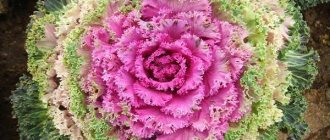Types and varieties of cabbage
The culture is characterized by species diversity. Cabbage comes in leaf and stem varieties and has different shapes, colors and tastes of the fruit. I will briefly describe the main varieties:
- White cabbage is a familiar cabbage with round heads of pale green leaves. Contains rare vitamin U, which treats inflammation of the digestive system and has a beneficial effect on its functioning. There are many varieties of this species - read about the best of them in a separate article.
- Red cabbage - does not differ in shape from the previous species, but has purple-violet leaves. This color is given to it by the high content of anthocyanin, a substance that actively removes harmful substances from the body.
- Colored is a dietary type, hypoallergenic and rich in vitamins. Used in baby food. Unripe cabbage inflorescences are eaten.
- Savoy - has unusual curly leaves that form into a head of cabbage. Contains a lot of protein, minerals, vitamin C and has a delicate taste.
- Beijing - the elongated heads of cabbage of this species have a loose structure, since the leaves do not fit tightly to each other. Contains a lot of vitamin A and C.
- Chinese is a petiole-leaf vegetable that does not form heads. The leaves are eaten, forming a rosette on a thick white stem.
- Kohlrabi is similar in appearance to a turnip or radish. But this is not a root vegetable, but an overgrown stem, which tastes like the stalk of white cabbage without the bitterness.
- Brussels sprouts - the heads of this type of cabbage grow on a half-meter stem and are the size of a walnut. They contain mustard oil, which gives them a piquant taste.
- Broccoli is similar to cauliflower, but has a rich green color. Rich in vitamins and antioxidants, which are well preserved when frozen.
Landing dates
The time for planting cabbage in open ground depends on two factors: the cabbage variety and the growing region. Early ripening varieties are usually planted in late April or early May, when the night temperature is 8-10 degrees. Medium and late varieties - 2-3 weeks later.
If you adhere to folk superstitions, focus on the bird cherry blossoms. Usually after this period there are no return frosts. Also, experienced gardeners advise planting early-ripening cabbage after the daffodils bloom, and late-ripening cabbage after the chestnuts have faded.
For work, choose a cloudy day, preferably before rain. Thanks to this weather, the seedlings will quickly take root in the garden bed.
Cleaning and storage
Cabbage can be harvested from the garden when the air temperature drops to -1 -2 °C at night. At lower temperatures, the heads of cabbage are likely to freeze, which cannot be allowed to happen - the level of keeping quality will decrease. Watering is stopped 2.5-3 weeks before the planned harvest. This is necessary so that starch accumulates in the heads, which contributes to a better storage process.
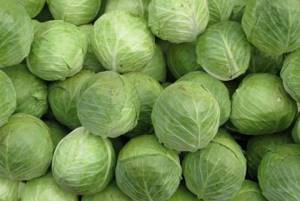
The forks are dug up with a shovel along with the roots and left for a day under a canopy. In the open air, the heads dry out or, as people say, become weathered. Next, they are sorted into healthy and defective. Cabbage touched by rot, pests, or spoiled during harvesting is set aside - it must be used first. The stalks are removed with a knife, leaving about 2 cm to the head, and the 3-5 outer covering leaves are left untouched. The preparatory work is done - the harvest can be stored in storage.
Related article:
Everything about sowing, growing and feeding cabbage
The ideal place to store cabbage, as well as other vegetables, is the cellar. The optimal temperature regime is +1… -1°С. Air humidity - 90-98%. As a rule, the temperature in cellars does not drop below zero and does not rise above 5-6 ° C, but, just in case, it doesn’t hurt to hang a thermometer there.
Good to know: Cabbage varieties that can be stored for a long time
To eliminate the possibility of mold, the walls in the room must first be whitewashed with lime. Remove trash and all unnecessary things. If there is no ventilation system, the cellar is ventilated periodically, about once every month and a half. Prepare racks that are installed horizontally in tiers. Alternatively, you can get by with wooden panels laid on the ground.
Forks are laid out on racks or suspended from the ceiling. To do this, the heads of cabbage are tied in pairs with a rope by the stalks and hung on special poles. This way they will be provided with uniform air access, plus it is convenient to examine them for damage. You can store cabbage in boxes stacked on shelves, or in buckets covered with sand.
Related article:
How to get rid of caterpillars on cabbage without chemicals?
Site selection and soil preparation
The cabbage bed should be in a sunny place with a deep groundwater level. The vegetable loves soil with neutral acidity. Acidic soil and high humidity provoke clubroot infection.
A week before planting, treat the soil with a solution of Fitosporin at the rate of 1 tablespoon per 10-liter bucket of water, and after it sprinkle the soil with wood ash. This will protect the plant from fungus, reduce acidity and create a favorable nutrient environment.
Be sure to follow crop rotation. Cabbage should not be planted after cruciferous vegetables - mustard, turnips, radishes, radishes and cabbage itself. The best predecessors are legumes, nightshades, carrots, garlic and cucumbers.
Pest Control
Insects and other pests can cause irreparable damage to the crop, so care must be taken to protect the plants.
Early white cabbage, as well as cauliflower, can be damaged by the cabbage fly, the larvae of which cause damage to the roots of the plant. At the same time, cabbage begins to wilt in hot weather, and its lower leaves become bluish.
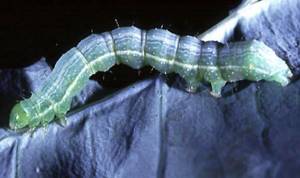
To combat this pest, use DDT dust or 6% hexachlorane dust, which is used to pollinate the plant after planting. The procedure is carried out two to three times at intervals of a week. The soil is watered using 30% thiophos (concentration - 0.03%). You can sprinkle the ground near the plant with mothballs mixed with sand (1:5).
A plant that has just begun to sprout can be damaged by the cruciferous flea beetle, which feeds on cabbage leaves. Early sowing and planting of seedlings can protect against this pest, which allows the plants to grow stronger before the flea beetle becomes active. To accelerate growth and increase resistance, the plant is fed using saltpeter and slurry.
The cabbage white butterfly (a white butterfly with black-spotted wings) can also damage the plant. The eggs, which are laid on the underside of the leaf, hatch into caterpillars. Sprawling throughout the plant, they feed on the leaves, eating them down to the rough veins. In the fight against cabbage whites, the same means are used as for cabbage moths.
Colonies of cabbage aphids, which suck the juices from the plants, cause enormous harm to the plant. The leaves then become covered with spots and begin to curl. The growth of cabbage slows down and the setting of a head of cabbage stops.
To combat this pest, before starting to set a head of cabbage, the plant is sprayed using anabasine sulfate (concentration - 0.2%) or 2.5% metaphos dust. Spraying with tobacco decoction is effective, to obtain which you need to pour tobacco dust (400 g) with water (2 l) and boil for 2 hours. The cooled solution is filtered. Then you need to add soap (50 g) to it and dissolve everything in a bucket of water.
Preparation of planting material
For planting, choose clean, healthy seeds without damage, stains or signs of mold. They are soaked in a fungicide solution for ten minutes. Use the drugs Vitaros, Maxim or others. As an alternative, you can use a pink solution of potassium permanganate.
Then the planting material is washed and hardened - kept in warm water, and then in cold water. To increase germination, you can treat them with Epin, Zircon or another growth stimulant.
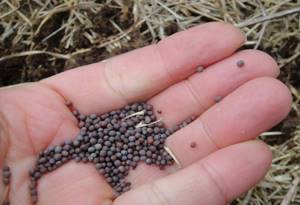
Planting by seedling method
Seedlings are planted 45 days before they are transferred to open ground.
Sowing seeds
After processing the seeds, they are dried and planted in a container with moist soil to a depth of 0.5-0.7 cm. The distance between the rows is about 3 cm. Cover the top with film or glass and maintain a temperature of +18... +20 for 4-5 days degrees.
When sprouts appear, remove the film and move the box to a bright place. Make sure that the seedlings are not exposed to direct sunlight, otherwise they will get burned. To develop, seedlings need 12-14 hours of daylight, so artificial lighting is used in the evening.
Until the true leaf is formed, the temperature is maintained at +6... +8 degrees, then raised to +15 during the daytime and to +10 at night. In such conditions, the seedlings will not stretch and harden.
Water no more than twice a week, avoiding excess moisture. Don't forget about loosening.
Picking
Cabbage seedlings are picked after the appearance of two true leaves. At the same time, pay attention to the condition of the sprouts - if they are too weak, it is better to wait a little.
Plastic cups, cassettes and other containers with a volume of 0.2-0.5 liters are suitable as containers. They must have drainage holes.
The seedlings need to be watered with warm water and after a few hours dived to a new place. Try to ensure that there is a small lump of earth on the roots. To do this, carefully dig up the seedling with a wooden stick and remove it from the soil.
After transplanting, the seedlings are removed to a warm place with a temperature of up to +22 degrees for a couple of days, and then returned to their previous conditions.
Transplantation into open ground
The readiness of seedlings to move to an open bed is indicated by the presence of 4-5 strong leaves on the seedlings.
The bed is dug up, weeds are removed and holes are made 15 cm deep at a distance of up to 50 cm from each other. The same space should be between the rows. Cabbage loves light and air, so it needs free space to develop.
You can plant carrots, onions or oats in the rows.
Add mineral fertilizers, a tablespoon of wood ash, manure or other nutrients to the bottom of each hole. They must be mixed with soil and sprinkled with an additional layer on top so as not to burn the root system.
The seedlings are taken out of the container, the roots are dipped in a solution of a growth stimulator and planted in the ground at the level of the cotyledon leaves. Sprinkle with damp soil and tamp down carefully.
During the first seven days, it is advisable to shade the planting with agrofibre to protect young seedlings from stress.
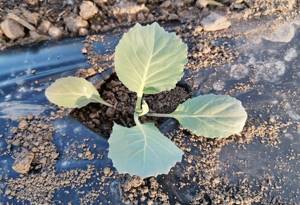
Picking early cabbage seedlings
You should first prepare containers for picking cabbage. Plastic glasses of various diameters can come in handy here. It is worth planting a larger plant in larger containers. The glass is filled with prepared soil.
Most often, cabbage grows quite thickly, so trying to pull out a single plant is pointless. They will stretch out in a crowd. You can use a simple fork to help. To pick cabbage for seedlings, you should choose plants with the most straight root system; cabbage with curved roots can be thrown away. Before planting cabbage, it is worth loosening the soil and making a hole into which the plant’s root is lowered. The cabbage sprout is inserted into the hole and a small amount of water is poured in, after which the root system of the plant can be buried and lightly compacted.
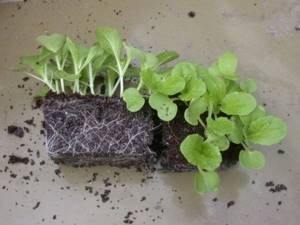
Then the glass with cabbage is watered again. It will take a short period of time for the water and soil to settle. If the soil in the cup is too wet, then you should not water the plant any more. During this time, you should prepare a place on the windowsill for seedlings, and you can also stick a sticker so that when planting, you do not confuse the varieties.
Latest articles about gardening
How to transplant Decembrist at home
How to transplant a cactus into another pot
How to transplant strawberries to a new place in the fall
Planting without seedlings
Cabbage is a cold-resistant plant, which allows it to be grown without seedlings. At the same time, the seedlings are hardened naturally, acquire strong immunity and form denser heads of cabbage.
The disadvantage of this method is the high consumption of seeds. You will need one and a half to two times more of them than with the seedling method. During cultivation, some seedlings may not sprout; some will need to be removed during the thinning process.
Seeds are planted in furrows or holes 2-3 cm deep. Up to five seeds are placed in one hole, and one seed every 10 cm in the furrows. After planting, the bed is sprinkled with a mixture of peat and humus and covered with agro-fabric or film. If you use film, make several holes in it to allow air to enter. The seedlings are kept under such a greenhouse for one month with regular ventilation and loosening.
The first thinning is done after the stems grow to 10-12 cm and 3-4 leaves appear on them. It is necessary to remove all weak and thin sprouts, leaving two strong stems in each place. After some time, a second thinning is done, leaving the strongest plant of the two. Removed seedlings are transplanted to a separate bed.
Garden bed care
The basic rules for caring for cabbage are as follows:
- It is necessary to water the plant twice a week, and with the onset of summer - every 2-3 days. Watering is carried out in the morning or evening, using up to 8 liters of warm water per square meter;
- Once a week, the beds are loosened to a depth of 5 cm. The work is carried out after watering or rain;
- 2-3 weeks after transplanting the seedlings into the garden, the cabbage is hilled up, raking the soil to the plant to a height of 25 cm. The second hilling is carried out after the formation of young heads of cabbage in July;
- Early cabbage is fed twice a season, middle cabbage – three times, late hybrids – four times. The first time is fertilized with ammonium nitrate after strengthening the seedlings in the beds. The second time - after two weeks with organic matter and minerals. The third is mineral fertilizers without nitrogen. The fourth - a solution of potassium sulfate at the rate of 15 g per 10 liters of water.
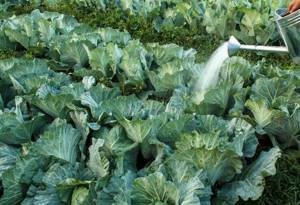
How to fertilize or feed cabbage in open ground
When the cabbage seedlings grow 6-7 true leaves, you can start fertilizing. These fertilizers should mainly consist of organic fertilizers, that is, humus or manure. But, of course, now there is no need to use fresh manure, but only its solution - 1:10. This is practically all that cabbage needs, since it loves organic matter very much.
In addition to manure, there is another potent nutrient - nettle. You need to collect about 5 kg of nettles, put it in a barrel, fill it with water. The nettle should ferment a little. You water the plants with this water. Alternate these waterings with watering with manure solution.
These measures are enough to grow a wonderful harvest.
In addition, the soil around the cabbage will need to be loosened after each watering, since it loves oxygen very much.
And you will also need to hill up. But this is only when the heads of cabbage begin to curl. Then it will begin to rise above the surface of the earth, and a leg will appear. To prevent the cabbage from falling over, you will need to rake the earth towards it.
But most importantly, do not forget to water it. It's better to overfill than underfill.
